Farming
What do these photos tell you about how 20th century farming was like?
Breaking Plains Sod
The tractor in this photo is pulling a breaking plow. It is breaking and turning over the sod on the plains.
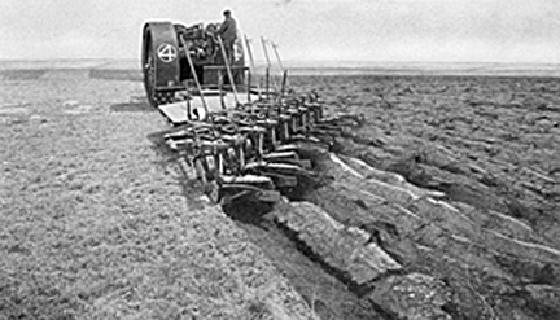
Photo: Denver Public Library, Western History Collection
More About This Topic
In the early 20th century, tractors like the one in this photo replaced horses to pull farm machinery. Farmers using tractors and breaking plows turned thousands of acres of grassland into wheat fields. But more production often decreased the prices farmers got for their crops.
Their Own Words
“The good years of the middle eighties ended with the dry years of 1889 and 1890. . . . There was a great exodus [departure] from this region in 1889 and 1890 and again in 1893-95. . . . In 1905 and 1906 settlers began to come in again and take up the land. They stayed on generally up to and through the World War [1914-1918]. During the war prices were high and we prospered. Since then there has been another slump and another exodus. Wheat now [1931] is down to twenty-five cents per bushel and times are pretty hard for the farmer. We have improved machinery and methods of farming that now generally insure a crop. In the early years our chief concern was whether there would be enough rain to mature our crops. Now our main problem is to sell at a decent price what we raise.”
Source: Millard Fillmore Vance, “Pioneering at Akron, Colorado,” Colorado Magazine, 8 (September 1931): 177.
Unloading Sugar Beet Trucks
This photo shows a long line of farm trucks loaded with sugar beets. The farmers are waiting to unload these sugar beets near Brighton, Colorado. This photo was taken about 1910.
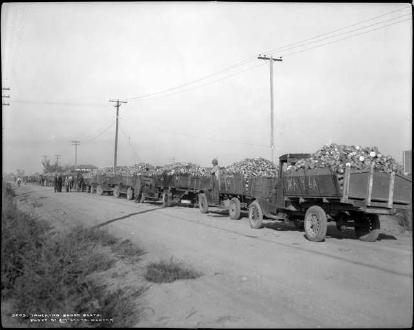
Photo: Denver Public Library, Western History Collection
More About This Topic
Most farmers harvested their sugar beets at the same time in the fall. As a result, they had to wait in long lines to deliver their crops to the sugar factory.
Their Own Words
"[A department of agriculture study] says in part, ‘the estimated cost of hauling in wagons from farm to shipping points averaged in 1918 about 30 cents per ton mile for wheat, 33 cents for corn and 48 cents for cotton; for doing the same hauling in motor trucks the averages are 15 cents for wheat or corn and 18 cents for cotton. The motor truck will make an average of 3.4 round trips per day over an average route from farm to shipping point of 11.3 miles, while wagons will make but 1.2 round trips over an average haul of 9 miles. The increased number of trips alone will place the motor truck in the lead and prove its economy. The fact of the matter is that, taking wheat as an example, the average wagon load was 56 bushels, while that of the load of the average truck was 84 bushels.’"
Source: Akron Weekly Pioneer Press, November 7, 1919.
Truck Loaded With Sugar Beets
This is a photo of a young farm boy. He is sitting in the back of a truck loaded with sugar beets. The truck is parked in a sugar beet field somewhere in northern Colorado.
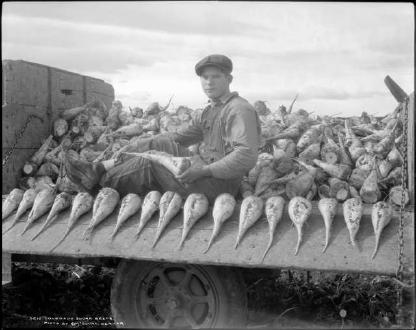
Photo: Denver Public Library, Western History Collection
More About This Topic
Notice the shape and size of the sugar beets. Notice too that the sugar beets are displayed on a chained sideboard of the truck bed. Moving the side board up and down made it easier to load and unload the sugar beets. This photo was taken in about 1910.
Their Own Words
"Think of the uses to which a truck can be put on the farm! It will haul produce to market and bring a return load of supplies to the farm. It will haul water to the live stock; it will haul wood for fuel; bring the implements to and from the fields, haul manure to the fields and bring back a load of stones on the return trip; will haul baled hay to the barns, corn bundles to the silage cutter; handle the grain, that is, both the corn on the cob and the threshed grain to the bin. It will haul live stock to market, thus making a saving of 5 to 8 percent over the shrinkage caused by driving stock on the hoof.”
"A motor truck offers the farmer the advantage of prompt delivery of his perishable produce, thus reducing waste through decay, as when handled by wagon or railroad, and turning into cash crops which would otherwise be lost. Through its speed it enable him to run his farm with less help, it increases the radius of land profitable for market gardening and small farms around the cities, and will pay for itself in the first six months of use through the actual net saving it will make on any modern farm.”
Source: Akron Weekly Pioneer Press, November 7, 1919.
The Results Of One Dust Storm
The dark cloud in this photo is a cloud of dust from fields in which farmers had plowed up the grassland. The photo was taken during the 1930s.
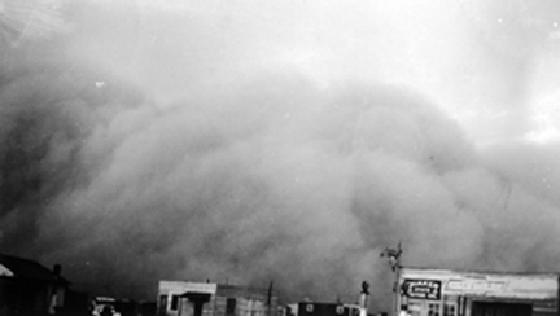
Photo: Colorado Historical Society
More About This Topic
Breaking the sod left thousands of acres of topsoil exposed. During the 1930s, a long period of drought and high winds on the eastern plains blew part of this soil away. It turned parts of southeastern Colorado into a "dust bowl."
Their Own Words
"It was so dark [during a dust storm] they let school out; Dad and I tried to drive just three blocks and we got lost.... The street lights went on at 2 P. M. . . .
Dust blew in the attics of many houses, and the weight of the dirt caused ceilings to fall in. Even the birds were afraid to fly.
Folks, that’s what a dust storm was, and once you have been in one, you’ll never forget it."
Source: Keith A. Cook, “A Whiskey Train and a Doughnut Day: Coming of Age on the Eastern Colorado Plains,” Colorado Heritage (Spring 1998), p. 4.
The Results Of One Dust Storm
This photo was taken in eastern Colorado in 1935. It shows drifted topsoil from nearby fields.
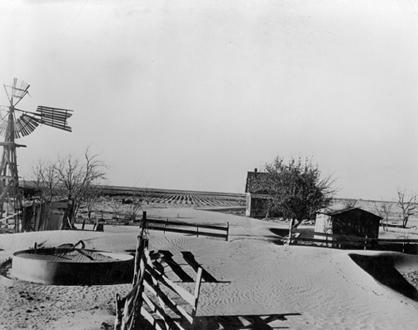
Photo: Colorado Historical Society
More About This Topic
The dust storms of the 1930s put many farmers out of business. Their farms were part of the dust bowl.
Their Own Words
“The hardships of the depression were [made worse] by the dust storms. A field that was green with wheat two inches high could be bare the next day after one of these storms hit, the wheat blown out by the roots. I remember one big storm. So dense was the dust that it [blocked out] the sun.”
Source: Theresa Lee, "The Depression Years," in Margaret J. Lehrer, Ed., Up The Hemline (Colorado Springs, 1975), p. 133.
Harvesting Grain
This photo shows the first field of spinach harvested by Japanese-American farmers at Camp Amache near Granada.
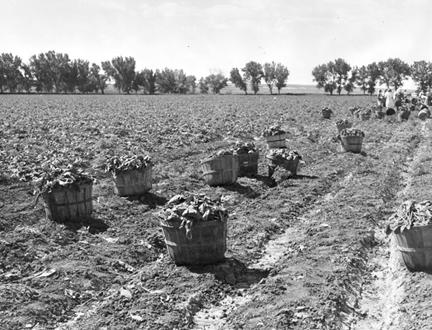
Photo: Colorado Historical Society
More About This Topic
Many of the Japanese-Americans from California who were forced to move to Colorado during World War II were good farmers. They harvested this crop of spinach in June 1943.
Their Own Words
"The relocation of the Japanese to Colorado has been a ‘God-sent’ gift to the hundreds of farmers, particularly in the sugar beet districts. The evacuee laborers have aided in the harvesting of this essential product. . . . [The] farmers who have employed Japanese labor, frankly admitted that their relationship has been of first class rating. It has been reported that, since the standards of living of the majority of the Japanese were much higher than those formerly hired by these farmers, the evacuee laborers have contributed to the improvement of working conditions and housing facilities in general. We are in receipt of many letters of appreciation for the excellent work done by evacuee laborers everywhere."
Source: Oski Taniwaki quoted in Robert Harvey, Amache: The Story of Japanese Internment in Colorado During World War II (Dallas, Taylor Trade, 2004): 67.
Harvesting Grain
The wheat field in this photo is being harvested by a self-propelled combine.
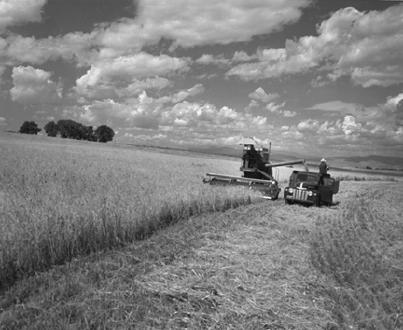
Photo: Colorado Historical Society
More About This Topic
Combine machines like the one in this photo replaced binders and threshing machines or separators. They cut the wheat and threshed the grain in one combined operation.
Their Own Words
"The promise of the West-then as now-is not always what it seems…. Those golden grain fields usually are not what you might think: an annual phenomenon [event]. They are usually the product of two years’ rainfall accumulated through the practice of summer fallowing. There isn’t enough rain or snowfall to grow a crop every year with 13 inches of annual precipitation [rainfall]."
Source: Lee Olson, Denver Post, Jan. 27, 1980.
Denver's Union Stockyards
This is a photo of the Union Stockyards in Denver.
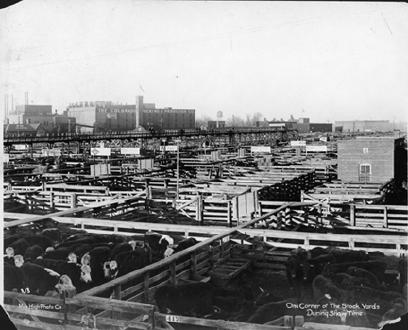
Photo: Colorado Historical Society
More About This Topic
Cattle raising remained an important business in Colorado throughout the 20th century. This photo shows the stockyards in Denver, where cattle were brought to be sold and slaughtered. The buildings in the background are slaughter houses.
Their Own Words
“The DENVER UNION STOCKYARDS. . . . established in 1886, occupies 130 acres. . . . This is the largest receiving market for sheep in the United State. . . . more than 1,000,000 pass through the yards annually. The plant, centered on the Livestock Building. . . . has facilities for handling 70,000 sheep, 33,000 cattle, 10,000 hogs, and 2,000 horses or mules. The cattle-branding chutes have a daily capacity of 4,500. The Stockyards Stadium, E. 47th Ave. and Gilpin St., a large rambling brick and frame building seating 4,400, is the scene of the annual National Western Rodeo, Horse Show, and Livestock Show.”
Source: Colorado Writers’ Program, Colorado: A Guide to the Highest State (New York: Hastings House, 1941): 151.

